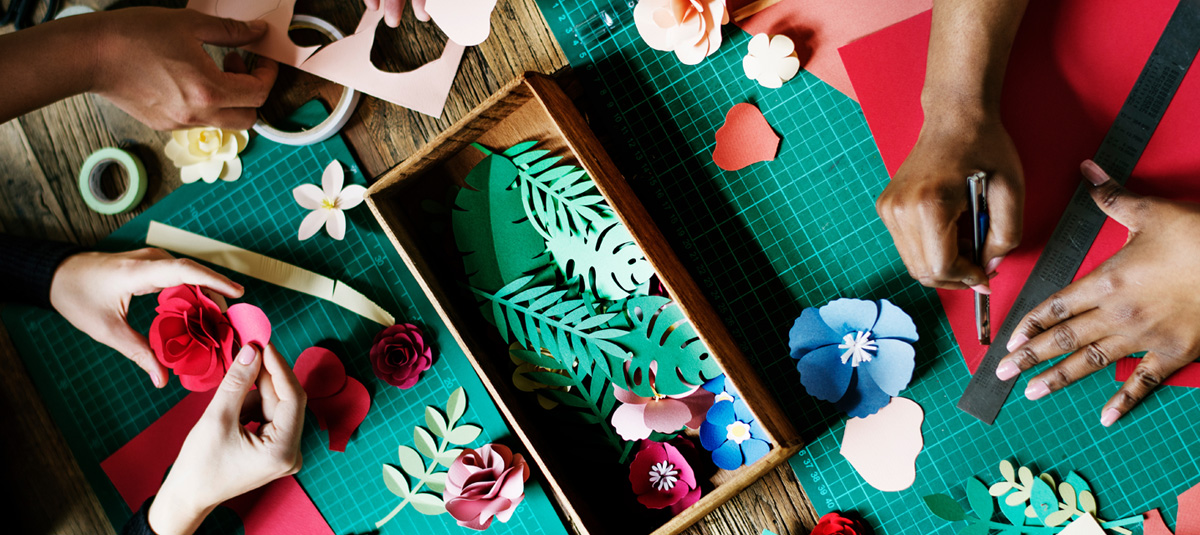Cardstock vs. Construction Paper

SHEET SMARTS: UNDERSTANDING THE BASICS
When it comes to fine art prints and craft projects like scrapbooking, the choice between cardstock and construction paper can hugely impact your final product's overall look and feel. Both paper types have unique properties and characteristics that make them suitable for different applications. While professional artists generally favor cardstock, construction paper can be a valuable option for crafters.
Understanding the distinctions between these two types of paper can help you make an informed decision for your next creative endeavor.
BUILDING BLOCKS: THICKNESS AND WEIGHT
Cardstock is thicker, heavier, and more durable than construction paper. The thickness can vary, but it typically falls within the range of 65 to 110 pounds per ream, providing a sturdy base for various art techniques and mediums. Its extra heft gives it the resilience to withstand extensive handling, folding, gluing, and more without buckling or tearing like construction paper can.
Although thicker than regular paper, construction paper is lighter than cardstock, ranging from 20 to 55 pounds per ream. Its lighter weight makes it easy to fold, cut, and manipulate. For example, many scrapbookers use cardstock as the base of their layouts, topping it with embellishments and accent pieces made from construction paper or colorful lightweight patterned papers.
FINISHES: ARCHIVAL VS. INFORMAL
Smoother to the touch, cardstock is ideal for client-facing materials that need to make a lasting impression. For the purposes of printing, cardstock offers a superior surface that allows for cleaner and crisper prints. Various coatings enhance visual appeal and durability. For example, Red River Paper offers a high-gloss cardstock with printable back, museum-grade paper, and canvas-textured matte photo paper.
On the other hand, construction paper isn’t designed for print jobs and won’t yield the same results. Its rougher, pulpy texture makes it perfect for projects involving glue, paint, cutting, and folding — providing endless possibilities for crafts.
COLOR RANGE: RAINBOW VS. REFINED
Imagine a school bin full of brightly colored construction paper, ready to rise to the visions of kindergartners. This is where construction paper shines: with a spectrum of hues to enliven casual craft pursuits.
While vivid-colored cardstock can be found, artists, designers, and photographers typically use it as a neutral base that enhances artwork and works well with inkjet printers. Various cardstock finishes — glossy, matte, and softly textured — impact printability. For example, our 88lb. Polar Matte Photo Paper has a soft white printing surface with excellent ink holdout capabilities, meaning the ink stays on the top layer, keeping details sharp, rather than absorbing too deeply.
PRICING: EXACTLY WHAT YOU’D THINK
Cardstock tends to be pricier due to its superior construction and archival qualities. Construction paper is more budget-friendly, making it suitable for temporary projects like quick mockups, color studies, or creating textural elements in mixed-media pieces.
THE FINAL CUT
Ultimately, the choice between cardstock and construction paper depends on your specific project requirements, budget constraints, and the desired longevity of your final product. By understanding the unique properties of each, you can make smart decisions that elevate your artistic vision and professional presentation.
To explore the many ways you can use cardstock, visit our resource titled Guide to Cardstock and Its Uses. If you care to nerd out on our Cardstock Weights and Paper Sizes Explained, now you know where to click. And if you’d like to see another cardstock comparison, check out Photo Paper vs. Cardstock: What Are the Main Differences?
Original Publication Date: August 12, 2024
Article Last updated: August 12, 2024
Related Posts and Information
Categories
About Photographers
Announcements
Back to Basics
Books and Videos
Cards and Calendars
Commentary
Contests
Displaying Images
Editing for Print
Events
Favorite Photo Locations
Featured Software
Free Stuff
Handy Hardware
How-To-Do-It
Imaging
Inks and Papers
Marketing Images
Monitors
Odds and Ends
Photo Gear and Services
Photo History
Photography
Printer Reviews
Printing
Printing Project Ideas
Red River Paper
Red River Paper Pro
RRP Products
Scanners and Scanning
Success on Paper
Techniques
Techniques
Tips and Tricks
Webinars
Words from the Web
Workshops and Exhibits
all
Archives
January, 2025
December, 2024
November, 2024
October, 2024
September, 2024
August, 2024
July, 2024
June, 2024
May, 2024
more archive dates
archive article list




